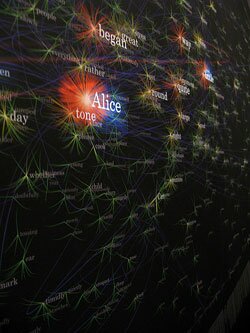
I recently sat down with Rob Zambrana, a graphic designer and marketing director from Charlotte, NC to talk about how the field is evolving. As virtually all media become increasingly digital, where do designers and professionals who cut their teeth in print fit in? And what should young graphic designers do to make themselves relevant and hireable in the market today?
Michelle Shull: Let’s start by talking about how you came to be a graphic designer. What led you to the career path?
Rob Zambrana: Well, I started very young as an illustrator. My first commercial art sale was at 13. In 8th grade I started picking up all the production stuff I could. The company I worked with did everything from paste-up to darkroom. We did generic design, we burned plates, ran a 2 color press, screenprinting – you name it we did it, and all when I was very young.
Michelle: In addition to being very competitive, success in illustration seems to be more about who you know than talent – the environment seems very incestuous. . .
Rob: Yes, that’s true. Design is all about networking and politics, where printing is about making money for the guys selling presswork. Landing clients is the only way agencies keep dollars coming in; there will always be somebody from whom to cultivate work. Once you’re in and you can pull off consistent work, you’re fine, unless you can’t keep up with or set the trends.
I kind of came from a different direction than almost everyone else. I was interested in being able to create high quality design and knowing how to make it a high quality printed product, so I tied myself to print very early on. Graphic design was sort of the happy medium of the creative end of commercial art and the technical side of knowing your workflow that’s so pivotal in printing.
 Michelle: So when you were starting out professionally, a background in print was an asset and a means of keeping steady work?
Michelle: So when you were starting out professionally, a background in print was an asset and a means of keeping steady work?
Rob: Well, you’re talking about almost 20 years ago, so yeah. Hand skills were key, and I was lucky enough to be involved just as everything was starting to move over to computers. PageMaker and Freehand were still Aldus applications. You needed to know how to produce things correctly or you’d be losing your profit margin to fixing your errors before going to press. By the time I started college computer art was still being taught on Commodore Amigas, and Production 1 was all about marker renderings and color breaks. I don’t think most people had the notion how much DTP was going to change how graphic design was done then.
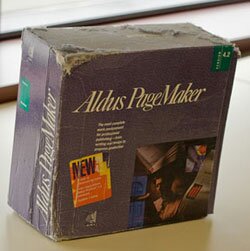 Michelle: Was the impending shift more predictable on the industry side than the academic?
Michelle: Was the impending shift more predictable on the industry side than the academic?
Rob: Without a doubt. Schools can’t teach trends or guesses. Printing was ahead of the small design agencies, too. Printing had to be ahead of the curve because it’s very competitive, and if your product looks lackluster you’re going to have to drop your fees or close your doors.
Funny thing, too, printing had a smaller niche. Letterpress got huge around then, as well. There were low tech shops that specialized in posters and lo-tech chic to get a very vintage look. [But eventually] low tech design got eaten up by the desktop clip art thing. I know a lot of commercial artists who couldn’t adapt and had to find another way to make a living.
Michelle: It’s a bit hyperbolic, I think, to say “print is dead” but it’s certainly facing a major downsize. Where do you see the future of graphic designers like yourself who have skills from a different era?
Rob: Print isn’t dead, but it’s certainly not a David and Goliath battle anymore. David threw the rock and he won, but the rock didn’t kill Goliath. You have to eliminate paper before you can kill print design, and while the Kindle is a great gadget, it’s not making Hammermill think about closing down their paper mills.
 If you even change your terminology a bit, print lives a little longer. It’s about sensibilities more than medium. Instead of electronic versus print, it’s static versus interactive. Nobody stopped taking pictures when video cameras came into the picture, and movies or TV didn’t go away with the introduction of the home movie camera. But it did make the creatives stop and look at what they were doing.
If you even change your terminology a bit, print lives a little longer. It’s about sensibilities more than medium. Instead of electronic versus print, it’s static versus interactive. Nobody stopped taking pictures when video cameras came into the picture, and movies or TV didn’t go away with the introduction of the home movie camera. But it did make the creatives stop and look at what they were doing.
Print designers are more capable in communicating a message that’s a single frame of action. Posters are changing to digital signage, newspapers are moving online, but you still need the essential basics of 3-6 second communication to make that effective. Motion video, animation and click-though web design just doesn’t mold to that mindset. The more versatile you are, the more options you have.
Michelle: In my experience, academia tends to run on trends in the creative disciplines. Do you think schools will continue to produce graphic designers able to function in both sides of that equation?
Rob: When I was in school, my college denied us entry to web design unless we took a class on Photoshop, which crippled an entire graduating class until we learned it on our own. That same school now pushes web and motion graphics more than illustration, which is good for them in one regard, but if the essence is function over form, the communication fails. That’s where schools either step up, or talent and skill start thinning the herd.
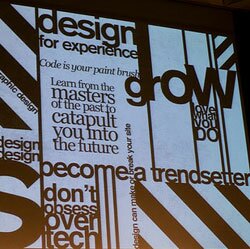 The basics have changed. It used to be hand skills translated to everything else you would need, but now it’s the ability to conceptualize. Can you communicate the same message in one frame with a headline and body copy as you can in a 30 second commercial, a web banner and a flash animation? That’s where the schools need to step up, and I think they are. It’s also what’s putting the advantage in the court of the agencies and design firms again, and moving the printers to a service agency on the same level as a web host.
The basics have changed. It used to be hand skills translated to everything else you would need, but now it’s the ability to conceptualize. Can you communicate the same message in one frame with a headline and body copy as you can in a 30 second commercial, a web banner and a flash animation? That’s where the schools need to step up, and I think they are. It’s also what’s putting the advantage in the court of the agencies and design firms again, and moving the printers to a service agency on the same level as a web host.
Schools have been essentially creating graphic designers or web designers, and they really are two different things. It’s too common to see an art director job listing which requires PHP or JavaScript coding, which is a programming piece far more than a design sensibility. There’s been a huge misconception as to what modern design really should cover, and it’s made the toolkit designers work with crossover into a lot of fields that aren’t necessarily a natural match.
Michelle: Can’t those skills be another medium to a designer, though?
Rob: It’s like expecting your programmer to be able to design a typographically well-constructed piece and know the essentials to guiding a reader through an ad. It’s possible, but you’re not putting an expert on the job. Why expect your designer to be an excellent programmer if you wouldn’t expect your programmer to be a top-level designer?
Michelle: That makes sense, and I get the argument that trying to squeeze too many titles out of one person is too much. But I can also see how having an understanding of the ability to write the code underneath the design could make a designer more marketable.
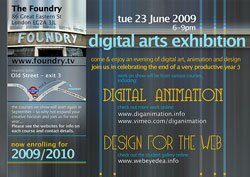 Rob: You can get a result, and it may be passable or acceptable, but if it’s the best it can be, you’re lucky and you need to give that designer a substantial raise. Don’t get me wrong, it’s a value add for a designer to be versatile. I can do a decent bit of hand illustration, I’ve done a bit of XHTML, CSS and JavaScript code, but would I expect to be able to earn a living doing either of them exclusively? No way.
Rob: You can get a result, and it may be passable or acceptable, but if it’s the best it can be, you’re lucky and you need to give that designer a substantial raise. Don’t get me wrong, it’s a value add for a designer to be versatile. I can do a decent bit of hand illustration, I’ve done a bit of XHTML, CSS and JavaScript code, but would I expect to be able to earn a living doing either of them exclusively? No way.
Michelle: I can see how changing the mindset of the companies who need both a web designer and a graphic designer would be difficult – I think both jobs tend to be either underestimated or misunderstood by people who don’t do them.
Rob: A designer creates a communication vehicle. If that vehicle is a website, a programmer creates the engine that moves the vehicle. And ideally, marketing supplies the target and metrics that make sure that the designer creates the right look and path for the vehicle, and the programmer can cultivate the right information from the people coming to it. To expect one person alone to be enough of an expert to do all of those to the best of three people’s ability is wishful thinking. That’s probably the biggest change going from static to interactive: the presence of a specialized team. That might even be a bigger change than print vs. web.
When you build a qualified team to suit that task, everybody can perform at their best potential. You may understand marketing, you may code a little and you may know your way around Photoshop and InDesign or XPress–but what do you do best? Where is your real strength? That’s what creates the best product. It’s about finding the most competent team to create the most quantifiably worthwhile final product.
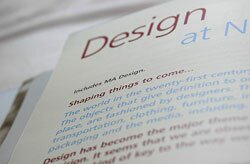 Michelle: What do you think a graphic designer, either one with a lot of experience or a brand new graduate, needs to do to stay relevant and hirable in the market today?
Michelle: What do you think a graphic designer, either one with a lot of experience or a brand new graduate, needs to do to stay relevant and hirable in the market today?
Rob: Be versatile, but don’t spread yourself thin. Learn a lot but don’t be afraid to key in on strength or a passion. If visual is your thing key in on it, but learn what you’ll need to communicate it. Design isn’t about pretty pictures; it’s about building a resounding impression. Learn how you can best make a message resound with your audience.
A lot of designers take a fine art approach, but it’s not about making your audience think about something other than your message. What can YOU do to communicate clearly, effectively, lastingly, and where can you innovate from there?
And know your industry, read the magazines, the blogs, watch what people are doing. The more aware you are the more you can adapt and be where things are going instead of where they are or were. If you happen to be self-aware enough to know this is your field in high school, learn about how the different arms of things work. If you do that early, you’ll be able to pare down where you should be taking classes and building the right degree to get you where you want to go. Don’t assume you know anything until you see it with your own eyes; you could be seeing an end result and not knowing where it comes from.
Credits:
http://www.flickr.com/photos/annamatic3000/
http://www.flickr.com/photos/evilpeacock/
http://www.flickr.com/photos/lauramoreno/

{ 5 comments… read them below or add one }
raf
Nice work. Thanks so much.
rafsistemleri I am really fan of your site. Thanks.Good work.
Hi there, I would like to subscribe for this weblog to get latest updates,
so where can i do it please help out.
obviously like your web-site however you have
to take a look at the spelling on several of your posts. Many of them are rife with spelling problems and I to find it very troublesome to
tell the reality on the other hand I will surely come
again again.
Hello to every single one, it’s in fact a
pleasant for me to pay a visit this site, it includes useful Information.